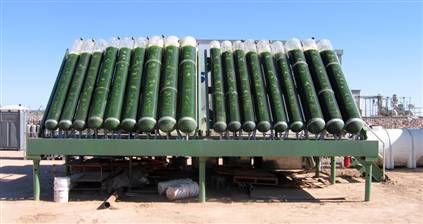Algae tested as fuel for Arizona power plant
Oct 26, 2006 - The Associated Press

PHOENIX - Algae may seem like one of life's little annoyances, but researchers hope the green, slimy stuff will one day replace one-third of the natural gas used to power an electric plant run by Arizona Public Service.
For a year, researchers watched algae multiply in huge, bubbling test tubes beneath the hot Arizona sun so they could find just the right strand of the microscopic single-celled plant.
The experiment has been so successful that it's about to expand into greenhouses on the plant grounds, and in time, be grown in such large quantities that it could be converted into fuel, cutting down on harmful greenhouse gases.
It works like this: Algae ingests carbon dioxide and releases oxygen in the photosynthesis process. Algae is laden with oils that can be used to produce biodiesel, starches that can be transformed into ethanol and protein that could have a market niche in cattle and fish feed.
Rocket scientist's idea
The idea was born three years ago, when Isaac Berzin, a rocket scientist at the Massachusetts Institute of Technology, was experimenting with growing algae on the International Space Station.
GreenFuel Technologies of Cambridge, Mass., which Berzin founded, then struck a deal with Arizona Public Service to conduct a demonstration project beginning last year.
"There is lots of sunshine, plenty of land, and since algae doesn't need potable water to proliferate, we were in business," said GreenFuel CEO Cary Bullock.
Construction is about to begin on a series of greenhouse-like buildings about 30 feet wide by 500 feet long that will house the algae.
"Our scientists think that we can get maybe even 200 tons of algae per acre annually during mass production," Bullock said, adding that commercial production is expected to begin in 2008 in Arizona and other sites in Australia and South Africa that the company has targeted.
Obstacles on algae road
But before the unique fuel can be produced on a mass scale, there are a few problems, including figuring out how to provide enough light to maximize algae growth and how to get the carbon dioxide in the water, where algae grows, fast enough to allow for maximum growth.
Qiang Hu, an assistant professor of applied biological sciences at Arizona State University, worked for two years on what Japanese scientists had hoped would be an algae-to-energy project in the late 1990s.
"I wish GreenFuel all the best," Qiang said. "But there were many technical problems in Japan, the most serious of which being that the algae would attach to the microfibers that were necessary to produce more light for growth inside the growth containers ... Much more energy was wasted and it turned out that the costs were just too great."
Bullock said he thinks those problems have been worked out during the past year of experiments but declined to discuss what he called "trade secrets."